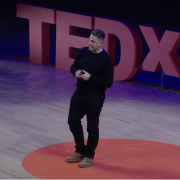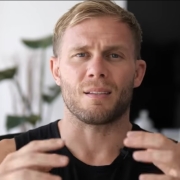Professor Damien Hughes has written and spoken about high performance in business and sport. He has written books and is co-host with Jame Humphry on one of the top podcasts in the UK – The High Performance Podcast.
In his recent TEDx Talk in Manchester – How Peak Performers Find the Path to Courage – he talks about the challenges we face when it comes to making change. This can be as individuals but also applied to organisations and teams.
There are loads of examples of people who have gone against the grain and challenged the perception of how something can be done differently. And all of them will have gone through Arthur Schopenhauer’s ‘Three Stages of a Known Truth’:
- Ridicule
- Violently opposed
- Accepted as self-evident
In his talk, Hughes uses a real life ‘hare and the tortoise story’ from the first ever ultra marathon in Australia. When the 61 year old Cliff Young turned up to enter the 875km race in his farming overalls and boots no one believed he would genuinely attempt to start the race. When the race started and the athletes all ran past him, it was clear that Cliff had his own unique shuffle style of running.
Needless to say, from his appearance, age and running style; Cliff Young was ridiculed by everyone involved in the event. But when Cliff decided not to take a break and carry on shuffling through the night while the other athletes were resting, he gradually built up a lead on them and went on to win the first ever Australian Ultra Marathon.
This was when Cliff Young’s approach was violently opposed and questioned. ‘He must have cheated’ they all thought. It was standard practice for ultra marathon athletes to stop for a 6 hour rest. But Cliff hadn’t bothered. As it turns out, there was nothing in the rules about rest times for the runners. It had just become a standard practice that everyone conformed to.
So it was no surprise 12 months later at the same race, when the majority of the race entrants had adopted the same Cliff Young shuffle running style. It had finally become accepted as self-evident.
The moral of this story isn’t the same as the ‘Hare and the Tortoise’ tale. It isn’t about chipping away at something slowly and steadily like the tortoise did. It isn’t about being humble which was the lesson for the hare. It’s about courage and having the bravery to stand out from the crowd to challenge the perceptions of others and keep going with it, even when you’re being ridiculed and opposed.
“Dead fish go with the flow”
We all like to think we can stand out from the crowd and walk our own paths. But how easy is it to do that? How strong do you have to be when faced with the challenges of doing something a different way?
For all the people who had the courage to do something differently and challenge the perceptions of the others around them, how many people didn’t? And how many ideas have been lost to the buckling of peer pressure or the fear of what others might think?
“It’s presence doesn’t always guarantee success, but it’s absence almost makes success impossible” – Courage
Allodoxaphobia – the fear of other people’s opinions – is the second highest phobia in the UK. It’s safe to say we all suffer from this at different points in our lives. Social anxiety and a fear of being judged can seriously damage our confidence and prevent us from standing out from the crowd.
We need that feeling of belonging and we don’t want to be rejected. This is why social conformity is often the easiest option. But do we want to just be ‘dead fish’ going with the flow? Or do we want to stand out and follow the path that we believe in, even if it goes against the grain?
To help with overcoming these fears and anxieties, Damien Hughes discusses processes that are used with professional athletes and high performers to keep them on the right track.
Visualise
Visualisation helps us all literally paint a picture in our minds. There is more and more scientific evidence that suggests visualising specific activities or scenarios can activate the same neural pathways in the brain as actually performing those activities or experiencing those scenarios.
Catastrophise
We often stay away from the ‘what if’ questions. No one likes being brought down to reality when someone starts trying to pick holes in our plans. But we need to be prepared for all eventualities. What if the plan doesn’t work out like we thought? How will we react if something does go wrong?
Creating these pre-mortems and asking ourselves what could or can go wrong, will ultimately help prepare us for hurdles we might have to face. By adding catastrophising with the visualisation, our courage can increase by up to 32%. It builds resilience for if/when something does go wrong.
Damien Hughes talks about writing a ‘Zander Letter’ which is a letter to yourself written as if it is 12 months in the future. In this letter you write about how you have achieved what you set out to achieve and how you overcame the obstacles that were in your way. This encourages you to really think in detail what could get in the way and how you will deal with it for when that happens.
Energise
Professor Rosabeth Moss Kanter came up with what is now known as ‘Kanter’s Law’ when it comes to change: In the middle, everything looks like a failure.
How do we keep ourselves energised to keep going when we’re stuck in the middle and it’s too far to go back and the finish line looks a million miles away?
Having the courage to keep going is the hardest part. Reminding ourselves why we are doing what we are doing. We are full of energy at the start of a project and we love the feeling when we’ve finished. But when we find ourselves in the messy middle and things start to feel overwhelming, we need to find a way to keep the energy to keep going in the times that she lost her confidence.
Hughes ends his talk with examples of reminders that athletes use to re-centre their minds in moments of doubt. He also quotes the ‘Paradoxical Commandments’ by Kent Keith which Mother Teresa often used to keep her own levels of courage high so she could keep doing what she was doing.
Courage doesn’t always come naturally. It takes work and practice like everything else. Visualising, catastrophising and keeping ourselves energised can help us all have the courage to make the changes we need to make and get to the finish line.


